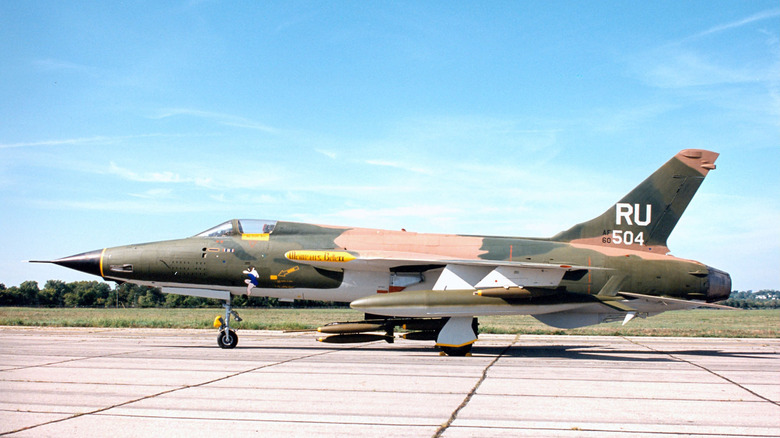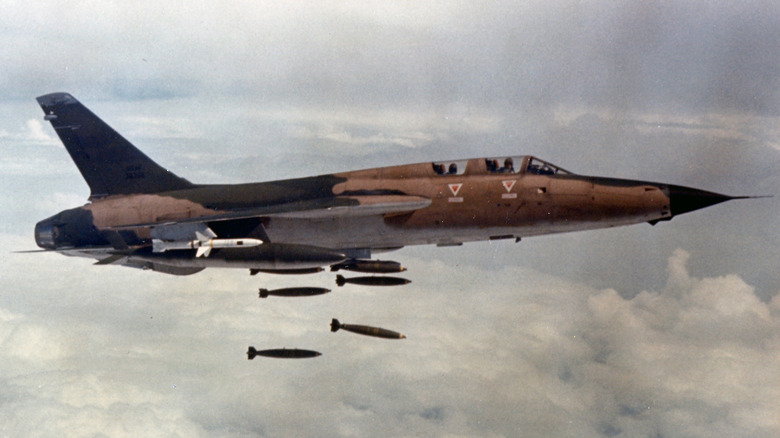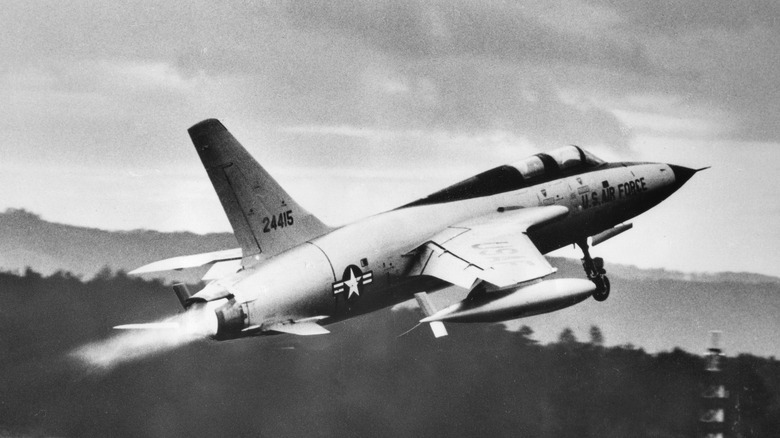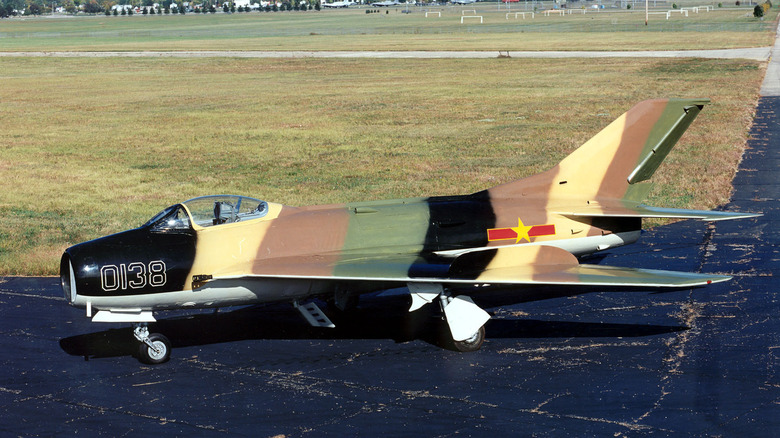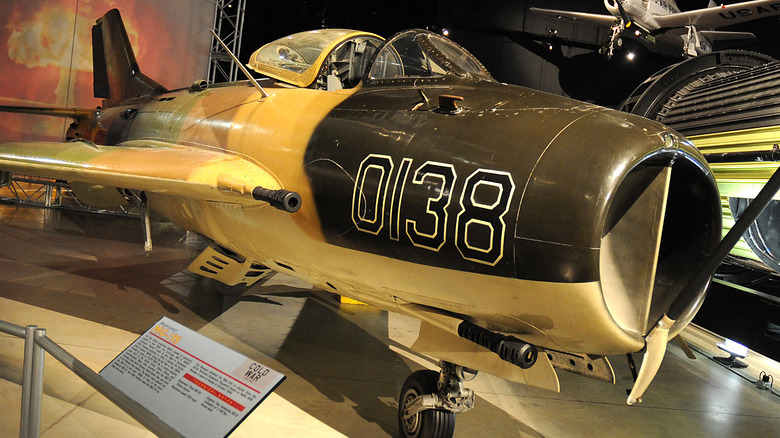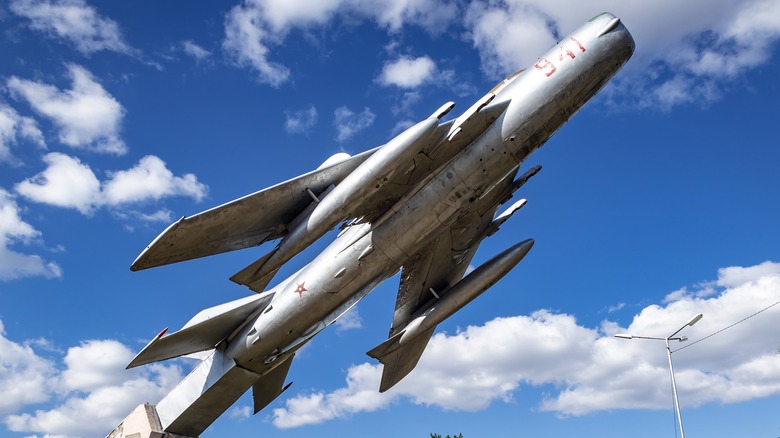The Biggest Differences Between The F-105 & MiG-19 Fighter Jets
In the early years of the Cold War, both the United States and the Soviet Union were engineering and producing new fighter jets and bombers at a historic rate. The Korean War saw the first combat between Soviet aircraft and American planes, and the Vietnam War only amplified it. Two jets, the F-105 Thunderchief and the MiG-19 "Farmer," fought extensively in the latter conflict. Aside from the obvious differences regarding each aircraft's allegiance, and things like shape and coloring, what sets an F-105 apart from a MiG-19?
Not all fighter jets fulfill the same role in combat. Some are used in an electronic warfare positions instead of traditional dog fighting, while others act more like bombers and close air support vehicles than something you would see Tom Cruise flying around with in "Top Gun." While both the F-105 and MiG-19 can ostensibly perform in a traditional fighter-to-fighter scenario, each aircraft's intended role can't be further apart.
A multi-role fighter
The Republic F-105 Thunderchief — which was also known as the "Thud," according to the United States Air Force — is fighter-bomber, meaning that it can shoot down other aircraft, and drop large amounts of ordnance on a target. The "fighter" part is accomplished via a 20mm Vulcan rotary cannon, and the "bomber" part consists of a 12,000 pound plus bomb carrying capacity. Although it was obviously (and thankfully) never used, that 12,000 capacity allowed it to carry nuclear ordnance. It was definitely a product of the Cold War era.
The F-105 was made in several variants, with the F-105D being the most common, first hitting the skies in 1959. This is the variant that saw duty in the Vietnam war. The F-105 in possession of the National Museum of the United States Air Force is confirmed to achieved two air-to-air kills of enemy MiGs in the war. Major Leo Thorsness (now Lieutenant Colonel) was awarded a Medal of Honor for his actions behind the flight stick of an F-105 on April 19, 1967. While on a bombing mission, he kept MiG fighters off the backs of a helicopter crew that was attempting a rescue of his wingman, who was shot down just moments earlier. That feat, by itself, is worthy of a medal, but to make matters more heroic, Thorsness kept his fellow soldiers safe all while running low on fuel.
In addition to acting as fighter bomber, the F-105 could be outfitted as a two-seater aircraft to embark on electronic warfare missions to disrupt and destroy enemy surface-to-air missiles in Vietnam. Such aircraft were called "Wild Weasels."
Fast and capable
On a technical end, the F-105 was also extraordinarily fast, achieving speeds of up to 1,390 miles per hour. That speed was accomplished thanks to its single Pratt and Whitney engine that threw out 24,500 pounds of thrust. For comparison, a T-38 Talon trainer jet only puts out a maximum of 3,300 pounds of thrust. The F-105 is also rather long, at a maximum of 67 feet in length depending on the variation, the wingspan is narrow at 34 feet, 11 inches. Outside of the Vietnam War, the F-105 didn't see much service and was retired in 1980.
Aircraft like the F-15 Strike Eagle and F-35 Lightning II are the F-105 equivalents that are flying today. Both aircraft are capable of bombing runs, electronic warfare — and perhaps most importantly, going incredibly fast. The F-105 served its purpose over its relatively short service life, but it was outclassed by more modern jets that were being developed in the 1960s and on.
The first mass produced supersonic fighter jet
On the other side of the Iron Curtain is the MiG-19, also called the "Farmer" by NATO. The MiG-19 first flew in 1955 for the Soviet Union, and is billed by the United States Army as the first mass produced aircraft capable of breaking the sound-barrier.
The sound barrier was broken for the very first time in 1947 by American pilot Chuck Yeager, so the Soviets developing the means to produce thousands of supersonic aircraft less than a decade later is quite the feat. The MiG-19's twin turbojet engines produced a maximum of 15,700 pounds of thrust to a top speed of around 902 miles per hour.
As it's really the first aircraft of its kind, the MiG-19 is downright primitive compared to modern fighter jets like the Eurofighter Typhoon or F-22 Raptor, and it was even outdated compared to the F-105 Thunderchief. Judging by the armament alone, the MiG was more gun-focused than missiles or bombs. The main guns were three 30-millimeter cannons: One was in the main fuselage, and one was on the base of each dramatically swept wing. It had missiles, but only space for two infrared K-13 air-to-air missiles. The armament was certainly deadly in the right context, but the MiG pilots were hopelessly outgunned (or out-missile'd) when going up against anything the United States was likely to fly.
The MiG was everywhere
The service life of the MiG-19 is complicated. Exact production numbers are not available, but the United States Air Force estimates that around 10,000 MiG-19s of all variations left Soviet Union factories. To make matters a little more cloudy, China also produced the MiG-19 under its own name as the Shenyang J-6. The Chinese version was reportedly a little faster, with a top speed of 960 miles per hour. Reportedly, a few J-6s are still in service with North Korea, nearly seven decades after the plane was first produced.
The MiG-19 and all of its many variations were exported to everyone, ranging from Cuba, to Poland, to Zambia. If you didn't like the United States in some capacity over the course of the Cold War, chances are the Soviet Union or China would try to sell you a fleet of MiG-19s. Given the wide proliferation of MiG-19s all over the world, the actual service life for different countries ranges from retiring in the 1960s, to perhaps still flying today. It was the AK-47 of fighter jets, and it was everywhere.
Apples and oranges
As far as purpose is concerned, the MiG-19 is strictly a fighter jet. The 30-millimeter guns and missiles could certainly do a number of ground targets, if the mission required it, but that was not the primary use. Compared to the Swiss Army Knife-like F-105 Thunderchief fighter-bomber, the MiG isn't quite as versatile. It's limited mostly by its armament and inability to carry anything more than a couple rockets or missiles at a time.
That's not to say it wasn't a success. The MiG-19 was wildly successful for the Soviet Union, just not in combat. It showed the rest of the world (for better or worse) that the Soviets were actually capable of making a serious effort in both production capacity and fighter jet technology. Dozens of countries adopting the MiG-19 isn't exactly the mark of an unsuccessful airframe.
For strict comparison, the MiG-19 and F-105 are almost nothing like each other. The MiG was intended to be a lithe gun fighter with some missiles for good measure, while the F-105 "Thud" was adapted to be used as a lightning-fast bomber and electronic warfare operator that could throw down with other jets if it needed to.
